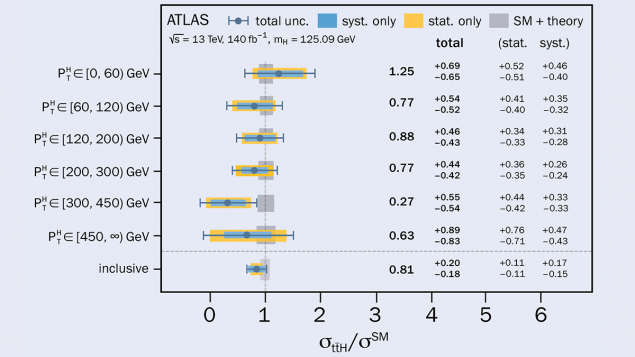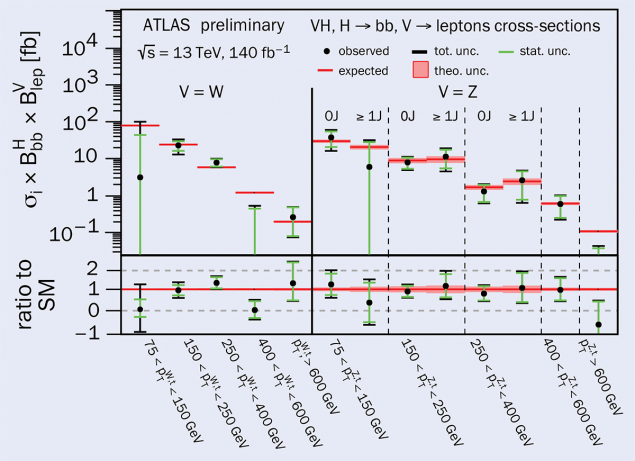A report from the ATLAS experiment.

One of nature’s greatest mysteries lies in the masses of the elementary fermions. Each of the three generations of quarks and charged leptons is progressively heavier than the first one, which forms ordinary matter, but the overall pattern and vast mass differences remain empirical and unexplained. In the Standard Model (SM), charged fermions acquire mass through interactions with the Higgs field. Consequently, their interaction strength with the Higgs boson, a ripple of the Higgs field, is proportional to the fermions’ mass. Precise measurements of these interaction strengths could offer insights into the mass-generation mechanism and potentially uncover new physics to explain this mystery.
The ATLAS collaboration recently released improved results on the Higgs boson’s interaction with second- and third-generation quarks (charm, bottom and top), based on the analysis of data collected during LHC Run 2 (2015–2018). The analyses refine two studies: Higgs-boson decays to charm- and bottom-quark pairs (H → cc and H → bb) in events where the Higgs boson is produced together with a weak boson V (W or Z); and, since the Higgs boson is too light to decay into a top-quark pair, the interaction with top quarks is probed in Higgs production in association with a top-quark pair (ttH) in events with H → bb decays. Sensitivity to H → cc and H → bb in VH production is increased by a factor of three and by 15%, respectively. Sensitivity to ttH, H → bb production is doubled.
Innovative analysis techniques were crucial to these improvements, several involving machine learning techniques, such as state-of-the-art transformers in the extremely challenging ttH(bb) analysis. Both analyses utilised an upgraded algorithm for identifying particle jets from bottom and charm quarks. A bespoke implementation allowed, for the first time, analysis of VH events coherently for both H → cc and H → bb decays. The enhanced classification of the signal from various background processes allowed a tripling of the number of selected ttH, H → bb events, and was the single largest improvement to increase the sensitivity to VH, H → cc. Both analyses improved their methods for estimating background processes including new theoretical predictions and the refined assessment of related uncertainties – a key component to boost the ttH, H → bb sensitivity.

Due to these improvements, ATLAS measured the ttH, H → bb cross-section with a precision of 24%, better than any single measurement before. The signal strength relative to the SM prediction is found to be 0.81 ± 0.21, consistent with the SM expectation of unity. It does not confirm previous results from ATLAS and CMS that left room for a lower-than-expected ttH cross section, dispelling speculations of new physics in this process. The compatibility between new and previous ATLAS results is estimated to be 21%.
In the new analysis VH, H → bb production was measured with a record precision of 18%; WH, H → bb production was observed for the first time with a significance of 5.3σ. Because H → cc decays are suppressed by a factor of 20 relative to H → bb decays, given the difference in quark masses, and are more difficult to identify, no significant sign of this process was found in the data. However, an upper limit on potential enhancements of the VH, H → cc rate of 11.3 times the SM prediction was placed at the 95% confidence level, allowing ATLAS to constrain the Higgs-charm coupling to less than 4.2 times the SM value, the strongest direct constraint to date.
The ttH and VH cross-sections were measured (double-)differentially with increased reach, granularity, and precision (figures 1 and 2). Notably, in the high transverse-momentum regime, where potential new physics effects are not yet excluded, the measurements were extended and the precision nearly doubled. However, neither analysis shows significant deviations from Standard Model predictions.
The significant new dataset from the ongoing Run 3 of the LHC, coupled with further advanced techniques like transformer-based jet identification, promises even more rigorous tests soon, and amplifies the excitement for the High-Luminosity LHC, where further precision will push the boundaries of our understanding of the Higgs boson – and perhaps yield clues to the mystery of the fermion masses.








